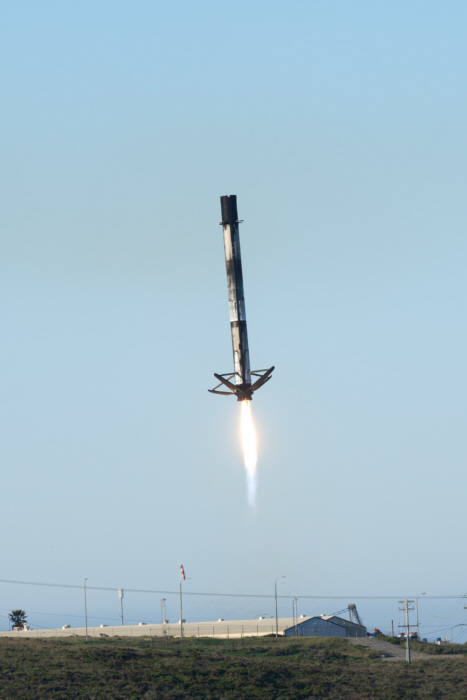

Space Systems Command News Release
2024 April 11

A Falcon 9 rocket first stage lands at Vandenberg SFB, Calif. following the launch of the first Weather System Follow-on - Microwave (WSF-M) satellite. U.S. Space Force photo by Airman 1st Class Olga Houtsma.
EL SEGUNDO, Calif. - Space Systems Command (SSC) and its mission partners successfully launched the United States Space Force (USSF)-62 Weather System Follow-on - Microwave (WSF-M) satellite aboard a SpaceX Falcon 9 rocket at 7:25 a.m. PDT, today, from Space Launch Complex 4 (SLC-4) at Vandenberg Space Force Base in northern Santa Barbara County, California. This mission brings new capabilities to the nation and its allies by placing the first satellite of two new generation of operational environmental monitoring satellites into orbit.
"The successful launch of SSC's WSF-M satellite is a tremendous accomplishment for the entire team and marks a pivotal moment in the U.S. Space Force's space-based environmental monitoring mission," said Col. Robert Davis, program executive officer, SSC Space Sensing. "We are looking ahead and are strategically positioned to ensure our warfighters have the vital environmental monitoring data necessary for effective mission planning and operations globally."
The SpaceX Falcon 9 team confirmed the rocket performed flawlessly and the satellite was safely separated from the rocket's upper stage approximately 55 minutes after launch.
"We had a fantastic launch today, said Col. Jim Horne, SSC's Launch Execution Delta senior materiel leader. "Working together with our mission partners, we placed an important asset on-orbit that adds remarkable capabilities for the nation and our allies. National security space launches like USSF-62 are a testament to our resolve to increase our warfighting advantage."
This launch was on a previously-flown Falcon 9 booster, flight tested on two prior commercial launches and meeting national security standards. The re-use of this booster is an innovative approach and has become a standard practice for SpaceX launches of the Falcon 9 rocket. Flying several missions with fewer new boosters saves on costs, storage and handling, and allows for added flexibility to manage launch manifests.
"Along with the commercial sector, we realize the benefits of reusability with every launch," said Dr. Walt Lauderdale, SSC Falcon Division chief and deputy mission director. "We've achieved excellent savings of tax-payer dollars and have expanded reuse to leverage the benefits for all our mission partners."
The WSF-M spacecraft is equipped with a passive microwave-imaging radiometer instrument and a hosted, government-furnished, energetic-charged particle (ECP) sensor. The WSF-M spacecraft is equipped with innovative technologies that address three high-priority DoD Space-Based Environmental Monitoring (SBEM) gaps, including ocean-surface vector winds, tropical cyclone intensity, and low Earth orbit (LEO) energetic charged particles. The spacecraft will address additional SBEM gaps including sea ice characterization, soil moisture, and snow depth.
"With the first WSF-M satellite, now safely in orbit, it will soon replace key capabilities currently provided by the legacy Defense Meteorological Satellite Program," said Col. Daniel Visosky, SSC's Environmental and Tactical Surveillance Acquisition Delta senior materiel leader. "The second WSF-M satellite will ensure we are providing these pivotal environmental monitoring capabilities well into the 2030s."
Space Systems Command is the U.S. Space Force field command responsible for acquiring, developing, and delivering resilient capabilities to protect our nation's strategic advantage in, from, and to space. SSC manages a $15 billion space acquisition budget for the Department of Defense and works in partnership with joint forces, industry, government agencies, academic and allied organizations to outpace emerging threats. Our actions today are making the world a better space for tomorrow. For more information, visit ssc.spaceforce.mil and follow @USSF-SSC on LinkedIn.
This story was originally titled "Space Systems Command Successfully Launches Next Generation WSF-M Weather Satellite on SpaceX Falcon 9 Rocket from California".
Copyright © 2024, Brian Webb. All rights reserved.